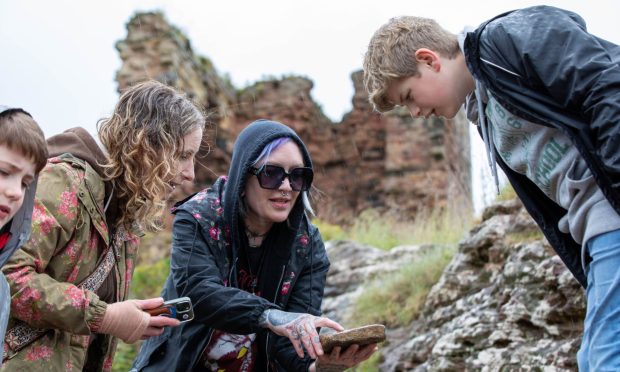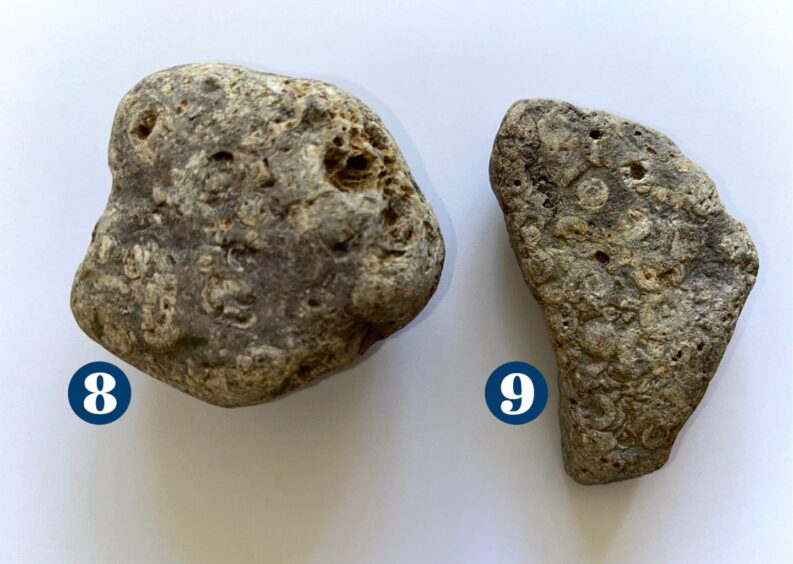Fife and Angus coastlines are rich fossil hunting grounds.
But how do you find fossils when you don’t know what you’re looking for?
And where are the best spots to look?
My kids are fascinated by fossils and we often come home with pockets full of rocks, unsure if what we’ve found is an interesting specimen or just a pretty stone.
So we decided to ask an expert how and where to find fossils in Fife and Angus – and geologist Dr Katie Strang was only too happy to help.
She joined us at a small shingle and rocky beach by Seafield Tower, in Kirkcaldy.
Having pushed our way through the overgrown path onto the beach, it was just seconds before we made our first discovery.
Crinoids from 320 million years ago
A large slab of limestone was laden with crinoid fossils. Crinoids are marine invertebrates which still exist today, often known as feather stars or sea lilies.
But these were from the carboniferous era, making them around 320 million years old.
“When I post pictures of these,” said Katie, “people often think they are human made objects. They look a bit like nuts and bolts and screws.”
Indeed they do. Had I seen them myself, I would have assumed they were traces left behind recently by small sea creatures.
Brachiopods and fairy coins
Some pieces of the crinoid fossils looked like a small spine. There were also cross-section pieces, tiny circles with a star-shaped hole, often called fairy coins.
There was plenty more to see. Brachiopod fossils among them. Again brachiopods exist today but are rarely seen, overtaken in number by the similar mollusc.
We also found septarian nodules, pretty mudstones interspersed with calcite which look like eggshell or tortoise shell and fluoresce under ultraviolet light.
There were fossils of corals which favour tropical climes, testifying to a time when a hot and humid Scotland lay close to the equator.
There were pretty pieces of red jasper and byrozoan fossils, traces of tiny ancient aquatic creatures or ‘moss animals’.
Rare sharks’ teeth
The beach by Seafield Tower is known for having limestone embedded with sharks’ teeth. Katie has been lucky enough to find some in the past, but said it is quite rare to do so.
Shortly after, our photographer Kenny picked up a large piece of rock which had caught his eye.
We knew it was a good find when Katie started getting excited.
“These are bits of really rare shark teeth,” she declared. “See how how they are a distinctly different colour and they have that shiny texture. That’s the enamel.
“What’s really cool is you have three types of teeth in there.”
The teeth, she said, were from pristodus, cladodont and petalodont sharks, all from the carboniferous era and long extinct.
“The pristodus ones are quite rare because they don’t last very long,” she explained, “they get broken up.”
Katie’s geology-inspired tattoos
The pristodus had pointy beak teeth for crushing shells, different from the sharp, triangular teeth we associate sharks with today.
However, the cladodont was a predator and had long piercing teeth, Katie explained.
It was similar to her favourite extinct shark the saivodus as tattooed on her knuckles.
Other tattoos on her hands reflect her love of fossils, rocks and all things geological.
She has ammonites on her palms. And a series of lines inked 5mm apart on her fingers are a measuring tool to give scale when photographing finds.
Her passion is obvious in other ways.
It’s addictive. The more you look the longer it will take you to go anywhere.”
Dr Katie Strang
A geology graduate of Glasgow and Durham universities, she confesses to having her pockets constantly full of interesting stones. She always has her eyes to the ground while out walking.
“It’s addictive,” she said. “The more you look the longer it will take you to go anywhere because you will be looking at everything.”
Katie lived in Charlestown, Fife, until recently being appointed curator of mineralogy and petrology at The Hunterian, in Glasgow.
She’s also a trustee of the Scottish Geology Trust and director of the Scottish Geology Festival (which this year runs from September 1 to October 6 and includes events in Angus and Fife).
Katie’s tips for finding fossils
So what is Katie’s advice to those hoping to find fossils?
“Keep your eyes open for anything that looks interesting or unusual – different colours, shapes, textures, etc.
“Use the BGS (British Geological Survey) geology viewer which is Google Maps but with rock types. It’s a good starting point to get an idea of the age and type of rocks of where you’re visiting.
“And visit a local museum if there is one. Larger museums will have also have lots of minerals and fossils on display.
“If people find something and they aren’t sure what it is or who to contact, they can always contact a museum or university.”
Kirkcaldy Galleries’ UNEARTHED exhibition on local geology, which runs until November 3, is also worth checking out, she said.
As is the Scottish Geology Trust website.
The Scottish Fossil Code sets out best practice for collecting, identifying, conserving and storing fossil specimens.
Where to find fossils and gemstones in Angus and Fife
Lunan Bay
Among the patches of shingle you can find gorgeous waterworn agate pebbles.
Auchmithie
Incredible examples of sandstone conglomerate cliffs formed by a giant Mississippi- sized river that once flowed over vast parts of the land over 400 million years ago. The beach is strewn with gorgeous cobbles and pebbles from these conglomerates, including red and yellow jasper, green epidote and other interesting pebbles.
Tayport
The Devonian lavas which outcrop here contain vesicles (small air holes left behind when lava cools and forms solid rock) and many contain agates. These agate nodules can often be found loose on this stretch of north-east Fife coast.
Dysart to East Wemyss
Much of the rock on the coast here is not in situ and was dumped when the coal industry was at its peak. In the loose material below the high tide line you can find a wide variety of carboniferous fossils including 310 million year old plant remains like lepidodendron and stigmaria.
Seafield, Kirkcaldy
Rocks here are around 330 million years old and the limestones were deposited in a shallow tropical sea. You can find lots of lose fossils in the shingle, like corals, crinoids and brachiopods. There are also small pieces of limestone and some might contain teeth from cartilaginous fish – sharks – like petalodus.
Preston Island
At the south end the sea defence is composed of carboniferous limestone which was quarried nearby. You can’t collect here since the rocks are there to protect from erosion, but it’s one of the best places to see examples of the carboniferous marine limestones. They’re full of fossils including brachiopods, corals, bryozoans, crinoids, etc.





















Conversation